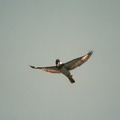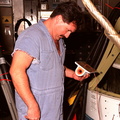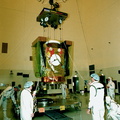
WIKIARCHIVES.SPACE
The Human Spaceflight Archive

Information
- Taken in
- Kennedy Space Center
- Fotograaf/bron
- NASA
- Omschrijving
- At Launch Pad 17-A, Cape Canaveral Air Station, a worker (left) runs a wire through a mounting hole on the second stage of a Boeing Delta II rocket in order to affix an external video camera held by the worker at right. The Delta II will launch the Stardust spacecraft on Feb. 6. Looking toward Earth, the camera will record the liftoff and separation of the first stage. Stardust is destined for a close encounter with the comet Wild 2 in January 2004. Using a silicon-based substance called aerogel, Stardust will capture comet particles flying off the nucleus of the comet. The spacecraft also will bring back samples of interstellar dust. These materials consist of ancient pre-solar interstellar grains and other remnants left over from the formation of the solar system. Scientists expect their analysis to provide important insights into the evolution of the sun and planets and possibly into the origin of life itself. The collected samples will return to Earth in a sample return capsule to be jettisoned as Stardust swings by Earth in January 2006.
- Aangemaakt op
- dinsdag 26 januari 1999
- Source link
- https://science.ksc.nasa.gov/gallery/photos/1999/
- Bezoeken
- 29
- Waarderingsscore
- Geen waardering
- Waardeer deze foto
- License
- CC BY-NC-ND
- Modified by WikiArchives
- No (original)
- Downloads
- 0
Mogelijk gemaakt door: Piwigo







